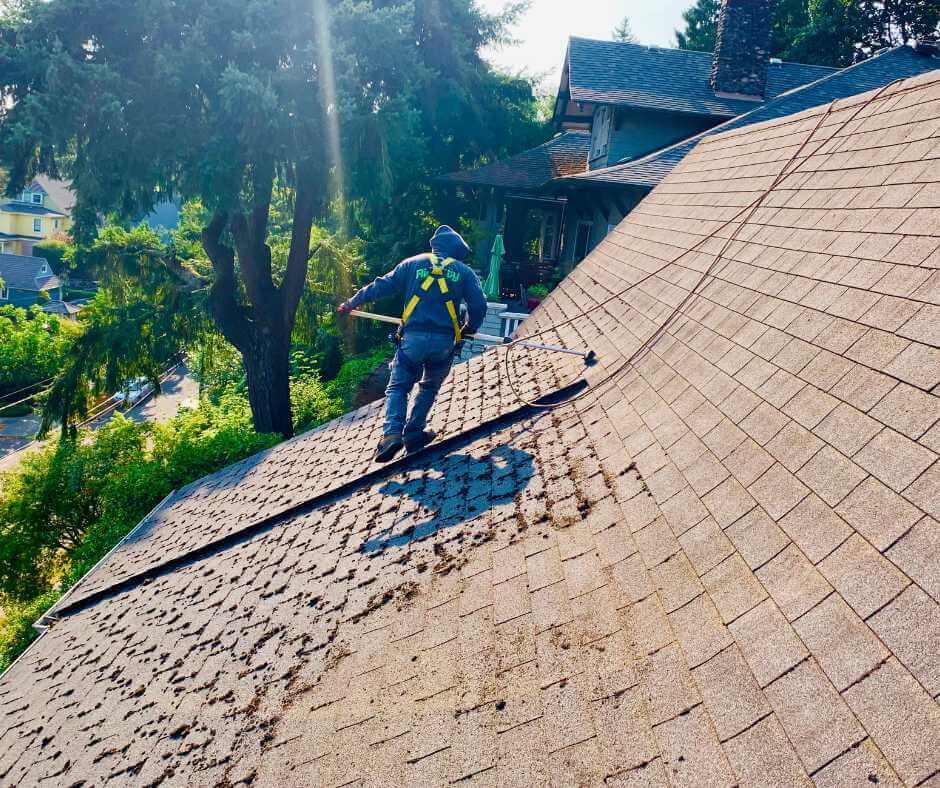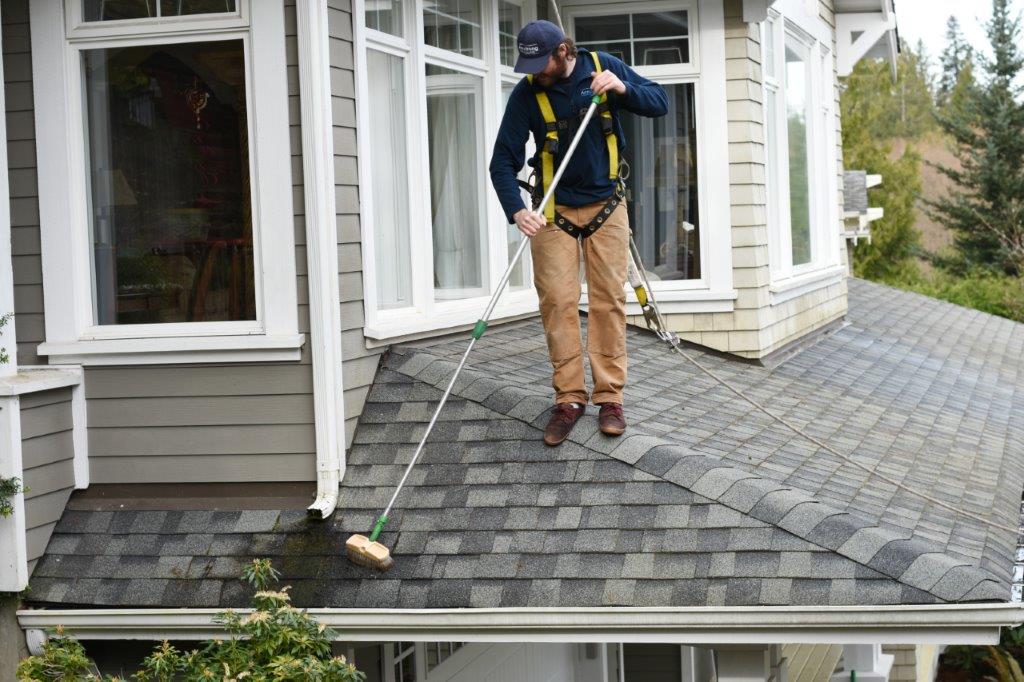Explore the Best Practices for Roofing System Moss Removal and Prevention
The persistent difficulty of roof moss can lead to substantial damage if not resolved immediately and effectively. Recognizing key locations prone to moss development is the first action in safeguarding your roofing's integrity. What are the most efficient approaches to guarantee a moss-free roof covering while preserving ecological responsibility and cost-effectiveness?
Identifying Roofing System Moss Issues
Recognizing roofing system moss concerns is an important action in maintaining the durability and honesty of your roofing system. Moss, an eco-friendly, squishy plant, tends to flourish in wet, shaded locations, making rooftops with overhanging trees or in areas with constant rains particularly prone. If left unchecked, its presence can lead to considerable damages. Moss preserves dampness, which can result in the damage of roof covering materials, potentially causing leaks or structural damage gradually.
To effectively identify moss issues, conduct normal examinations, specifically after lengthy durations of rainfall. Try to find patches of dark or eco-friendly discoloration on the roofing system's surface, specifically along the tiles' sides where moss can conveniently secure. In addition, evaluate the seamless gutter systems and downspouts for any type of debris that might show moss development, as these areas can facilitate moisture buildup.
Acknowledging early signs of moss growth enables for timely treatment, stopping additional problems. Moreover, it is very important to examine the roofing system's exposure to sunshine and guarantee adequate drain to reduce future events. By comprehending the conditions helpful to moss growth and consistently monitoring your roofing, you can safeguard versus potential damages, keeping the roofing system's capability and aesthetic allure.
DIY Moss Elimination Strategies
As soon as roof covering moss concerns are identified, resolving them without delay can protect against more damages. Do it yourself moss elimination uses a cost-efficient strategy for home owners eager to spend time and initiative.
A typical DIY method involves using a mixture of equivalent parts water and vinegar. Fill up a spray container with the solution and use it straight to the moss-covered areas. Enable the service to sit for 20 to thirty minutes. This damages the moss, promoting less complicated removal. As soon as the moss is loosened up, utilize a soft-bristle brush or broom to delicately scrub it away, making sure not to damage the shingles.
Wash the roofing thoroughly with water to make sure all solution residues are gotten rid of. Routinely evaluate your roofing system post-treatment to capture any persisting moss early, keeping the roofing system's honesty and longevity.

Expert Moss Therapy Options
When taking care of extensive roofing moss concerns, expert moss therapy options offer a reliable and reliable solution. Engaging the experience of professionals guarantees a detailed strategy, leveraging specialized tools and commercial-grade treatments that are typically a lot more powerful than those readily available to the average property owner. These services normally start with a thorough inspection to evaluate the seriousness and degree of moss growth, complied with by the application of targeted therapies created to remove moss while maintaining the honesty of the roof covering products.
Among the main benefits of expert treatments is the use of premium moss-killing agents that are both fast-acting and resilient. Experts typically apply these agents using specialized tools, such as low-pressure sprayers, to make certain even insurance coverage and stop damage to the roofing system. Specialist services frequently consist of follow-up assessments and maintenance strategies to keep an eye on roofing system conditions and protect against reoccurrence.
Additionally, specialist roofing moss treatment service providers are educated to determine underlying issues, such as inadequate drain or inadequate sunshine, that may visit site add to moss expansion (roof moss removal). Dealing with these origin as component of a detailed treatment plan enhances the long-lasting effectiveness and sustainability of moss elimination efforts, making sure a well-maintained and tidy roof
Eco-Friendly Moss Avoidance
Beyond the range of expert therapies, green moss avoidance strategies offer sustainable options for property owners aiming to preserve a moss-free roofing. Cooking soda increases the pH level, creating an inhospitable environment for moss development.
Incorporating copper or zinc strips along the roof ridge can act as a safety net - roof moss removal. When it rainfalls, these steels launch ions that prevent moss expansion. This technique is not only environmentally pleasant however likewise offers a lasting service without the need for chemical treatments
One more eco-conscious approach involves improving roofing air flow and sunshine direct exposure. Trimming looming tree branches permits more sunlight onto the roof, normally hindering moss by minimizing wetness levels. Additionally, making certain correct roofing drainage can aid stop water build-up, a primary stimulant for moss growth.
Regular Roof Covering Maintenance Tips
How usually should house owners participate in roof upkeep to guarantee long life and performance? Ideally, house owners ought to perform a detailed roof examination bi-annually, preferably in springtime and fall. These examinations allow for the very early detection of possible issues like harmed shingles, blocked seamless gutters, or emerging moss development, which can compromise the roofing's integrity if left untreated.
Normal cleaning is an additional important aspect of roofing system upkeep. Debris such as leaves, branches, and dust ought to be gotten rid of to stop water retention, which can cause algae and moss proliferation. Cleaning up seamless gutters is equally crucial, as clogged up gutters can trigger water overflow, harming the roof covering and exterior walls.
Along with cleansing, homeowners ought to likewise be cautious about trimming overhanging branches. Trees that are as well near to the roof covering provide shade and moisture, producing a suitable setting for moss to thrive. Branches can harm roof shingles throughout tornados, leading to leakages.

Conclusion
Dealing with roofing moss properly calls for a detailed technique that integrates identification, removal, and avoidance strategies. Using DIY techniques, such as making use of vinegar or sodium bicarbonate, provides eco-friendly remedies, while investigate this site expert treatments make certain complete removal. Preventive actions, including the installment of copper or zinc strips and enhancing sunlight direct exposure through cutting, are important. Normal maintenance and prompt repair work significantly add to sustaining a moss-free roofing, ultimately extending the roof's life expectancy and enhancing general architectural stability.
By recognizing the problems helpful to moss development and routinely monitoring your roofing system, you can protect versus prospective damages, keeping the roof covering's capability and visual appeal.
Routinely examine your roofing post-treatment to catch any recurring moss early, maintaining the roofing system's integrity and longevity.
When dealing with comprehensive roofing system moss issues, professional moss treatment options give a reliable and reliable remedy. These solutions commonly start with a complete assessment to examine the intensity and degree of moss growth, adhered to by the application of targeted therapies created to eliminate moss while preserving the integrity of the roofing materials.
Additionally, ensuring correct roofing drain can help stop water build-up, a primary driver for moss growth.